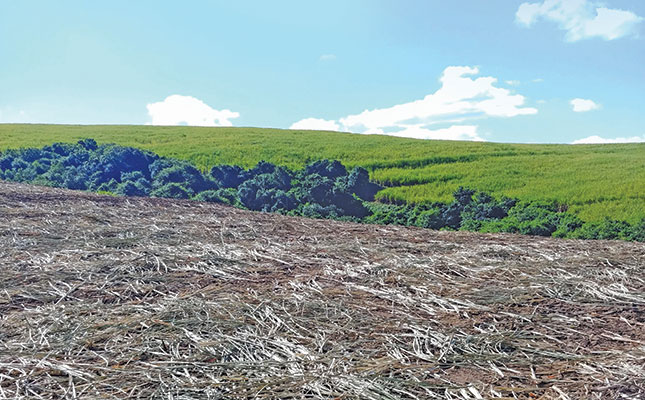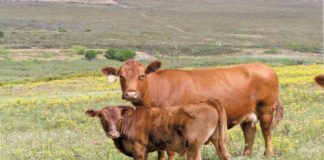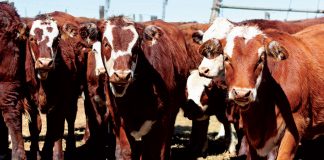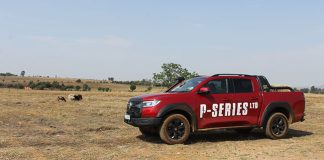
Photo: Deon Schröder
Sugar cane (Saccharum officinarum) is a perennial crop that can be harvested a number of times once first growth and regrowth have reached maturity.
Deon Schröder, who farms in KwaZulu-Natal’s Dalton area, grows 600ha of dryland sugar cane, of which about 55% is harvested in an 18- to 24-month rotation.
“We get roughly five harvests from a field, which means we plough out and replant a field every 10 years,” he says.
“Traditionally, a field would lie fallow for three to six months between ploughing out and replanting. Like many other South African sugar cane growers, I struggle with an increase in soil acidity over the life of a field. Even though sugar cane can tolerate soil acidity to some degree, it’s commonly a severely limiting factor, resulting in serious yield losses.”
Soil acidity
South Africa’s sugar cane farmers typically deal with increased soil acidity by applying lime or gypsum to the surface of a fallow land immediately after a crop plough-out.
According to Schröder, most sugar cane farmers aim to keep their lands totally free of weeds, using herbicides as well as hoes.
In addition, they use chemical fertilisers to boost growth. Based on soil test results, a fertiliser mix is applied at a rate of about 120kg/ha nitrogen (N), 20kg/ ha phosphorus (P) and 200kg/ha potassium (K). Ratoon crops are given the same mix, but a slightly higher rate of N – between 140kg/ha and 180kg/ha.
“When a field is ready for harvesting, we burn it to remove as much leafy material as possible from the standing stalks to make harvesting and processing easier,” says Schröder.
He maintains that, due to the intensive use of machinery and implements, which reduce biodiversity, traditional South African sugar cane farming fits into the ‘industrial agriculture’ paradigm.
Unsurprisingly, therefore, sugar cane operations are increasingly experiencing yield losses, as well as threats from weeds, pests and diseases. This proves that new thinking and actions are required if the sector is to remain sustainably productive.
In his search for answers, Schröder read and consulted widely, finally coming across the book Dirt to Soil: One Family’s Journey into Regenerative Agriculture by US farmer Gabe Brown.
From this and other sources, Schröder distilled five principles of regenerative agriculture:
- Limit soil disturbance;
- Keep soil covered with organic matter as much as possible;
- Have living roots in the soil for as long as possible;
- Maximise biodiversity above and below the soil surface; and
- Use livestock as strategic tools to improve soil health.
Starting off
Determined to implement these priniciples in his lands, Schröder began by tackling the challenge of minimising soil disturbance. While it is still necessary to plough out an old sugar cane crop and then ridge furrows in which to plant seed cane, he found that it was not always essential to plough surface-applied lime or gypsum into the soil profile.
He now does this only for lands that have an acid saturation of 20% or more and therefore require urgent remedial action.
“If we do plough a field, I can still sleep at night because I know there’ll be at least a 10- to 12-year break before it needs to be ploughed again. So, our method could be described as a type of rotational tillage system, with the aim of gradually reducing tillage until we can give it up.”
The second challenge was to find a way to retain soil cover despite having to burn the mature crop before harvesting and milling. To this end, he employs so-called cool burns wherever possible.
While hot burns consume both dry and green leaves of the cane, cool burns usually destroy only the dry leaves, leaving the green leaves at the top relatively undamaged.
The green leaves are hacked off by cane cutters, who then create one windrow from the stalks and a separate windrow from the cane tops.
The stalks are thereafter loaded and transported from the burnt field, and the tops are spread as mulch on the soil surface of the land.
“The coolest burn possible is achieved by burning early in the morning, when the air temperature is at its lowest and there’s dew on the cane. I try to avoid burning in the afternoons and evenings, when it’s warm and there’s no moisture in the air.
This is relatively easy in autumn and spring, but gets quite tricky in winter, especially with the August winds,” he says.
Protecting the soil
Once the windrows of stalks have been collected, the cane tops are spread out as mulch on the soil surface. It also decomposes, providing valuable organic nutrients to the soil, increases earthworms and other beneficial soil life, helps trap rain for infiltration, and protects the soil surface from erosion and being baked by the sun.
With sugar cane being a perennial crop, living roots are almost always present in the lands. According to Schröder, it is important to ensure that these belong to a diversity of plants
“On this issue, we sugar cane farmers have failed badly. We’re now reaping the unwanted rewards of wall-to-wall sugar cane fields and monocropping year after year. I’ve prioritised bringing plant diversity to my farm in an effort to repair the damage.”
He says that his father, Louis, had long ago begun trialling cover crops, such as black oats and Sunn hemp, on fallow sugar cane lands between ploughing out and replanting. But when Schröder took over management of the family farm, he discovered that this was insufficient on its own.
He therefore added crop rotation, with N-fixing soya bean. However, although the first two soya bean crops were in excellent health throughout the growing phase, yields at harvesting were “shocking”.
Frustrated, but determined to persevere with his regenerative agriculture plan, Schröder turned to Simon Hodgson and Kate Volbrecht of AGT Cover Crops for advice. The pair introduced him to the multi-species cover crops concept.
“I realised that if we used this approach, I could achieve all of the objectives I was trying to obtain with crop rotation, and more,” he recalls. “We could increase the diversity on the farm to a much greater extent than with a soya bean crop, not go broke in the process, and stress levels would be kept much lower.”
He has since successfully grown a number of mixed-species cover crops on what previously were fallow sugar cane lands. To maximise their productivity, he uses warm and cool season mixes.
The former includes sunflower, forage sorghum, pearl millet, maize, cow peas and Sunn hemp, while the latter includes tillage radish, Japanese radish, common vetch, black and white oats, rape, and mustard.
These mixed-species cover crops help improve soil organic matter, soil life and structure, and even reduce soil compaction.
When planting cover crops, he uses his fertiliser spreader to broadcast the seed onto the soil surface, and a high-speed disc to lightly work the seed into the soil.
Going even further, he has begun trialling intercropping cover crops with the sugar cane, and is seeing promising results.
“My sugar cane soils are coming alive again. I’m finding increased soil life, and improved soil aggregates and overall structure. We’re now partnering with AGT Cover Crops, the South African Sugarcane Research Institute [SASRI], Piket Implements and other farmers to do more scientific and controlled trials to fine-tune our methods and record some accurate data,” he says.
Livestock as friends
Schröder says that introducing animals to the sugar cane lands involved a major mindshift. Although owning a small ‘hobby herd’ of Bonsmara-type beef cattle since 2011, he initially restricted them to camps of planted kikuyu and any available natural veld.
Today, as part of his regenerative agriculture strategy, he grazes them on mixed cover crops growing on the sugar cane lands between ploughing out and replanting. The cattle are then moved to the more secure kikuyu camps at night.
“My cattle are fat and happy. Interestingly, since planting cover crops, I haven’t bought or made any bales. I’ve noticed that the animals are consuming far less lick and are in excellent condition, even through the toughest part of the year. Growing my herd and increasing stock density are my next priorities,” he says.
The cattle’s hooves trample organic matter into the soil surface, and their dung and urine add organic nutrients for soil microbes and the sugar cane. The cattle also provide income-generating beef.
Earthworms and their castings have continued to increase noticeably in the soil where Schröder is implementing the five key principles of regenerative agriculture. He has also seen a significant difference between the results of soil samples taken from his ‘new’ fields, and those from the fields where he has still to implement his sustainability practices.
Increase in predatory insect numbers
Yet another benefit of the cover crops is that they have attracted a multitude of beneficial predatory insects. Ladybirds, for example, are proliferating, which bodes well for future sugar cane yield as they help to control yellow sugar cane aphids (Sipha flava).
“With our new approach, we’ve seen sugar cane yield improvements ranging from 12,5% to 75% above our previous records, and some of those initial records were after good rainfall years.
“I’m not quite prepared to say all of these increases are as a result of the cover crops and crop rotation. Some of the credit must go to SASRI and its plant breeding department, which has come out with really great, modern sugar cane varieties that are having a hugely positive impact.
“But I believe our regenerative strategy is also playing a big role and is definitely contributing to these improvements.”
Email Deon Schröder [email protected].
This article is based on Schröder’s presentation at the 2019 No-Till Conference, held
from 3 to 5 September at ATKV Drakensville in KwaZulu-Natal.











